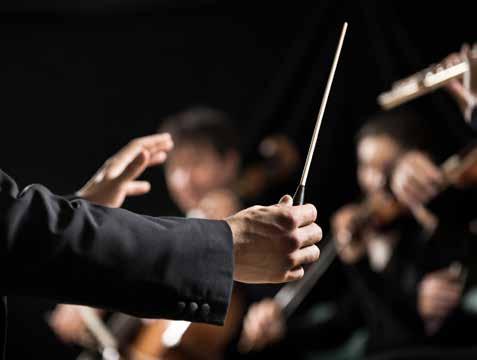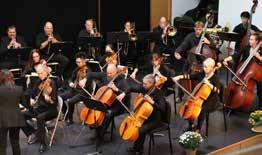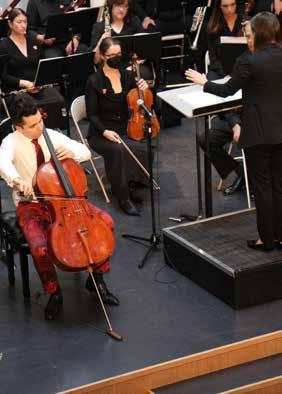Kamloops Symphony Society
BOARD OF DIRECTORS
John McDonald, ICD.D | President
Steve Powrie | Vice President
Tyler Klymchuk | Treasurer
Kait Methot | Secretary
Kathy Collier
Lisa Fuller
Christy Gauley
Lucille Gnanasihamany
Gabriele Klein
Rod Michell
Sydney Takahashi
Simon Walter
HONOURARY LIFE MEMBERS
Bonnie Jetsen
Art Hooper
ADMINISTRATION
Executive Director
Daniel Mills
Music Director
Dina Gilbert
Office Administrator
Sue Adams
Operations Coordinator
Sam Bregoliss
Marketing Coordinator
Ryan Noakes
Librarian
Sally Arai
Orchestra Personnel Manager
Olivia Martin
Production Assistant
Adrien Fillion
Chorus Master
Tomas Bijok
Collaborative Pianist
Daniela O’Fee
Chorus Administrator
Proud Member of Orchestras Canada, the national association for Canadian orchestras

Marnie Smith
Music Director Emeritus
Bruce Dunn
MUSIC DIRECTOR
Music Director Dina Gilbert is a Canadian conductor passionate about educating audiences of all ages and broadening their appreciation of orchestral music through innovative collaborations. This commitment, as well as Dina Gilbert’s extensive repertoire—often highlighting Canadian and women composers—have shaped her career and the orchestras she has worked with over the years. Regularly invited to conduct in Canada and overseas, Dina Gilbert attracts critical acclaim for her energy, precision and versatility.
In addition to conducting the Kamloops Symphony, highlights of the 2022-2023 season include debuts with the Orchestre national des Pays de la Loire and a tour with the Orchestre national de Metz in France and return invitations with the Orchestre symphonique de Montréal and the Orchestre symphonique de Québec. As the Principal Conductor of the Orchestre des Grands Ballets Canadiens de Montréal, she will perform Stravinsky’s Rite of Spring and Prokofiev’s Cinderella. Over the years, Dina has been invited by leading Canadian orchestras including the Orchestre symphonique de Montréal, the Orchestre Métropolitain, the Toronto Symphony Orchestra, the Hamilton Philharmonic and the Orchestre symphonique de Québec. She also conducted performances in Oregon and North-Carolina, in Colombia, Spain, France, and in Niigata and Tokyo. Her innate curiosity towards nonclassical musical genres and her willingness to democratize classical music have brought her to conduct the Orchestre Philharmonique de Radio France and the Orchestre national de Lyon in several Hip Hop Symphonic
programs featuring renowned Hip hop artists I AM, MC Solaar, Youssoupha and Bigflo & Oli. Dina is also renowned for her expertise in conducting multidisciplinary projects such as cineconcerts performances (The Red Violin, The Artist, E.T. the Extraterrestrial) as well as Video Game soundtracks (The Montreal Video Game Symphony, Outlast, The Amazing Spiderman 2).
As the Music Director of the Orchestre symphonique de l’Estuaire (20172022), Dina expanded the symphonic repertoire and has reached thousands of children with her interactive and participative Conducting 101 workshops. As the founder and artistic director of the Ensemble Arkea, a Montreal-based chamber orchestra, she premiered over thirty works from emerging Canadian composers. From 2013 to 2016, Dina Gilbert was the assistant conductor of the Orchestre symphonique de Montreal and Maestro Kent Nagano, also assisting guest conductors including Zubin Mehta, Sir Roger Norrington and Lawrence Foster.
Dina Gilbert earned her doctorate from the Université de Montréal and she polished her skills in masterclasses with Kenneth Kiesler, Pinchas Zukerman, Neeme Järvi and the musicians from the Kritische Orchester in Berlin. Awarded the Opus Prize of “Découverte de l’année” in 2017, Dina Gilbert was also named as one of the “50 personnalités créant l’extraordinaire au Québec” in 2018 by the Urbania Magazine. She has also received support from the Canada Arts Council, the Conseil des arts et des lettres du Québec and from the PèreLindsay Foundation.
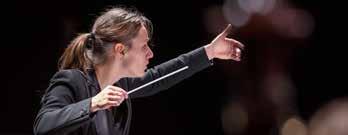 Dina Gilbert
Dina Gilbert
Orchestra
VIOLIN
Elyse Jacobson concertmaster *
Sandra Wilmot++
VIOLA
Ashley Kroecher*
CELLO
Martin Kratky*
BASS
Maggie Hasspacher*
FLUTE / PICCOLO
Heather Beaty*
OBOE
Marea Chernoff*
CLARINET
Sally Arai*
*Principal +Acting Principal ++Substitute Principal
Chair Sponsors
BASSOON
Olivia Martin*
HORN
Sam McNally*
TIMPANI
Caroline Bucher*
Geoff & Judith Benson | concertmaster
Rod Michell | assistant concertmaster
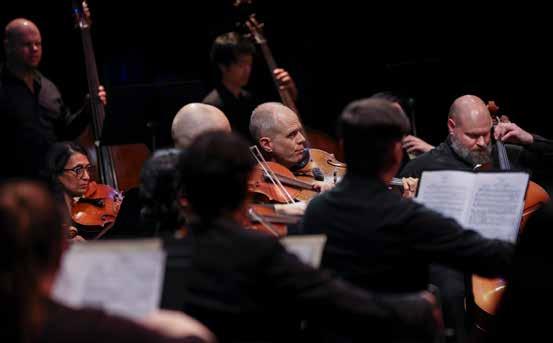
Gabriele Klein | principal second violin
June McClure | principal viola
Anonymous | principal cello
Eleanor Nicoll | principal flute
John & Joyce Henderson | principal clarinet
Kelvin Barlow | principal bassoon
Hugh & Marilyn Fallis | principal trumpet
KSO Chorus
Marnie Smith, Chorus Administrator
The KSO Chorus provides local singers with the opportunity to perform masterworks for choir and orchestra in concert with the Kamloops Symphony Orchestra. The Chorus has joined the Orchestra for a wide variety of Pops and Masterworks performances.
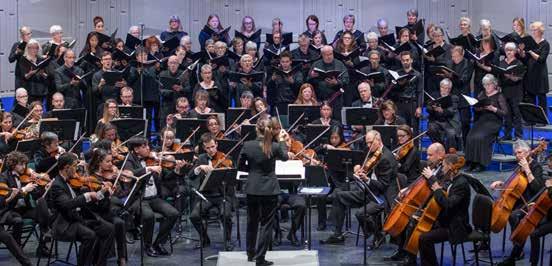
Amanda Ahner
Nichole Annis
Guram Asatiani
Cem Bicer
Rita Bittante
Amanda Bond
Janet Brunsgaard
Alan Buchanan
Lynn Eberts
Tom Eccleston
Calder Fadden
Kristine Faulds
Ethan Gelinas
Heather Gnoato
Marcia (Marcy) Gofsky
Cam Grant
Shannon Gruen
Adrianne Hajdasz
Tracy Hajdasz
Mary Hunter
George Johnson
Stacey Jyrkkanen
Elaine Karas
Chris Kempling
Lyndon Kinley
Eric Kitt
Kennedy Love
Michelle Marginet
Sylvia Markowsky
Heather Martin
Diane McArthur
Candace Morrison
Peter Nieuwold
Linda Oliver
Chantal Oliver
Charene Perog
Marlene Peters
Bonnie Peterson
Elizabeth Reichenback
Jason Richard
Janice Rutherford
Mia Sage
Marnie Smith
Samantha (Sam) Snucins
Patricia Spencer
Maatje Stamp-Vincent
Gisele Strodl
Jill Timko
Evelyn Vipond-Schmidt
Florence Walde
Robert Walter
Viviane Wingerak
Cynthia Yaunish
Alana Yeung
Michelle Zwolak
Tomas Bijok, Chorusmaster | Daniela O’Fee, Collaborative Pianist
Emma Jang Soprano
Vancouver-based soprano Emma Jang holds her M.Mus in Opera Performance, having just completed her degree at the University of British Columbia under the tutelage of director Nancy Hermiston. She last appeared with UBC Opera as Gretel in Humperdinck’s Hansel and Gretel this past December. Past credits with UBC Opera include Second Wood Sprite (Rusalka), Barbarina (Le nozze di Figaro), Gianetta (The Gondoliers), Corinna (Il viaggio a Reims), and First Spirit and Papagena (Die Zauberflöte), in addition to performing in productions such as Shadow Catch, Pasażerka and Les contes d’Hoffmann. Emma has also performed in collaboration with local companies such as Opera West, Bard on the Beach, Opera Unbound, and Players & Singers. She understudied the role of Dukdukdiya for Vancouver Opera’s touring production of The Flight of the Hummingbird, and was also a recipient of this year’s Tony and Hildegard Cavelti Foundation Award, which was distributed as part of the Vancouver Opera Foundation Bursary Program.

GUEST ARTIST
Micah Schroeder Baritone
Canadian-American baritone Micah Schroeder has been praised for his “smooth as glass lyrical contours” (The National Post). A recent graduate of the opera studio of Opéra de Lyon, the Vancouver Opera Yulanda M. Faris Young Artist Program and the Opera Idaho Young Artist Program, Schroeder is a champion of contemporary repertoire and recently curated and created the documentary film DENKMAL as an Artist-in-Residence for Pacific Opera Victoria. In 2022 Mr. Schroeder created the role of Quinn in the world premiere of Nicole Lizee’s RUR: A Torrent of Light with Tapestry Opera in Toronto debuted with the Festival Opéra de St. Eustache as Marcello in La Bohème and returned to Highlands Opera as the titular role in Eugene Onegin. Mr. Schroeder has been featured in other companies including Aspen Opera Centre, Banff Centre, Against the Grain Theatre, Saskatoon Opera, Vancouver Symphony and Kamloops Symphony. Notable roles in Schroeder’s repertoire include the title roles in Don Giovanni, Il Barbiere di Siviglia, Eugene Onegin and Pelléas et Mélisande, Schaunard in La Bohème, Count Almaviva in Le Nozze di Figaro and Baryton-martin in Vivier’s Kopernikus.

GUEST ARTIST
A traditional Requiem Mass is a longestablished religious service of the Catholic Church sung in Latin, that honours the death of particular individuals. Many classical composers such as Haydn, Mozart and Berlioz use elements of this traditional Catholic structure in their Requiems, that include familiar sections such as the Requiem aeternam, Dies Irae and Sanctus. As we will hear, Brahms’ German Requiem is not a “requiem” in this traditional manner. Brahms created his own highly personal version of a requiem, avoiding the traditional Latin and, instead, selecting passages from the German Lutheran Bible and Apocrypha. This gives his German Requiem a more clearly Protestant quality, not surprising from a Protestant North German composer from Hamburg.
February 2, 1865: “If you want to see our mother once again, come immediately.” That’s how the telegram read that Johannes Brahms received from his brother Fritz. Brahms, who was in Vienna, made all the speed he could, but it is a long way from Vienna to Hamburg, and Christiane Brahms, who had had a stroke, was already dead when Johannes arrived. By all accounts she had had a difficult life. Brahms, who loved her deeply, was grief stricken.
The death of his mother is often cited as the event that brought the German Requiem into being. However, Brahms already had the idea for a “cantata of grief” long before his mother’s passing. The death of his friend and mentor, Robert Schumann in 1856, when Brahms was only 23, was most likely the
origin of the idea: his determination that, at some point he should honour the memory of the musician who had recognized his potential and nurtured his emerging talent. During the decade that followed Schumann’s death, Brahms experienced other sources of grief, some personal—his parents’ divorce, his own dreams of an ideal relationship—some professional—his ambition to become a conductor, his long struggles with his First Symphony (eventually premiered only in 1876).
As early as 1861 Brahms had made a list of biblical selections from the Old Testament, New Testament and the Apocrypha, for an “elegiac cantata” “solely in the German language.” Although these choices are all from the Bible, the work does not reflect any particular ecclesiastical liturgical tradition, and they reveal the different approach he has taken. Unlike the Catholic Mass for the Dead, his chosen texts are not supplications imploring God to intercede for the dead, nor are they prayers for the souls of the deceased; rather, they are directed at those who remain, who are in mourning and are seeking hope. The texts accept humanity’s transience but also confirm its eventual fulfillment. His choices sometimes reflect human doubt and uncertainty, but that adds an element of authenticity to the impact of both words and music in their expression of comfort. This provision of consolation for the bereaved is the work’s chief aim and makes the German Requiem an interdenominational work that affirms the power of remembrance and of contemplation. Brahms himself
PROGRAMME NOTES
admits the power of his music and of the process of its composition: “I have now found consolation! I have overcome what I thought I would never be able to overcome…. I have now cast off my grief, it has been taken from me; I have finished my music of grief as a blessing of the suffering.”
Clara Schumann (Robert’s widow) wrote to Brahms after he had sent her the score of the last two parts of the work in 1867: “I am altogether imbued with your Requiem, it is a mighty piece of music, seizes the entire person as little else can. The deep gravity, united with all the magic of the poetry has
a wonderful, shocking and calming effect… I feel the whole, rich treasure of this work in my innermost being and the enthusiasm that speaks from every piece moves me deeply. . . “
Brahms conceived his German Requiem for a choir of two hundred singers and a massive orchestra intended to match them. The Kamloops Symphony has chosen to perform the chamber ensemble version arranged by Joachim Linckelmann, which is for a string quintet, a woodwind quintet and timpani.
A German Requiem Movements 1 through 7
1. The words from the Gospel of Matthew from the Sermon on the Mount, “Blessed are they that mourn…” and then from Psalm 126,” They that sow in tears…” call for a subdued but comforting opening. This movement, which contains unaccompanied choral sections, shows Brahms’s familiarity with elements of Renaissance church music.
2. With its texts from the Epistle of Peter on human frailty and from James and Isaiah on patience and fulfillment, the opening of the second movement has often been described as a march in triple time in which the timpani are noticeable and ominous. After the mood brightens, the march returns and leads to a triumphant climax “as the ransomed of the Lord shall return”
that combines the full power of the orchestral forces with the chorus who sing of “Freude” (Joy) in a manner reminiscent of Beethoven, before the movement draws to a quiet close.
3. Movement three begins with a recitative by the baritone soloist who pleads urgently for knowledge of his mortality in words from Psalm 39. It develops as a dialogue between soloist and chorus, who respond by declaring, “My hope is in Thee,” an uplifting assertion that Brahms casts in the form of a powerful fugue.
4. The choral fourth movement, “How lovely are thy dwellings fair” from Psalm 84 is perhaps the most well-known movement from the Requiem, and the only one to have
PROGRAMME NOTES
a concert life on its own. It is often considered the emotional centre of the work, the sweet tenderness of its lilting melody expressing an optimism that replaces the more serious mood of the opening parts. Brahms uses the repetitive features of a fugal structure again towards the movement’s end as a way of providing emphasis on the desire for God’s presence.
5. Along with the orchestra and chorus, the fifth movement features a soprano soloist and words taken from John’s Gospel, Isaiah, and Ecclesiasticus. In spite of the opening declaration, “And ye now therefore have sorrow,” the focus in the movement is on the certainty of comfort, with the chorus providing words of reassurance. The music’s key is bright, the melody is steady, and when the soloist sings Isaiah’s words of a mother’s comfort it is hard not imagine how close Brahms’ music must have come to reflecting his own need for consolation.
6. Movement six opens with the chorus quietly reaffirming the uncertain nature of human future in words from Hebrews, “For here we have no abiding city.” Then the baritone soloist joins the chorus to announce the prophecy of the
Resurrection as described by the apostle Paul in 1 Corinthians, “Behold, I show you a mystery,” words familiar to many from Handel’s powerful setting for bass solo in Part 3 of Messiah. Here Brahms creates an equally triumphant effect with the chorus, who then embark on an equally powerful double fugue praising God in words from Revelation, “Thou art worthy, O Lord,” that brings movement six to a firm and unshakeable conclusion.
7. The concluding movement of the Requiem is clearly designed as an artistic bookend, emotionally, spiritually, and musically, as Brahms uses the music of the opening chorus of movement one, “Blessed are they that mourn,” here at the end for the complementary words from Revelation, “Blessed are the dead.” The mood of this conclusion is one of restrained exultation—not the dark tones of the second movement, nor the urgent pleading of the third movement or serenity the fourth movement, but a quiet tranquility closer to the consolation of the fifth movement and the confidence of the sixth movement.
PROGRAMME NOTES
1. Selig sind, die da Leid tragen, denn sie sollen getröstet werden. Die mit Tränen säen, werden mit Freuden ernten.
Sie gehen hin und weinen und tragen edlen Samen, und kommen mit Freuden und bringen ihre Garben.
2. Denn alles Fleisch ist wie Gras, und alle Herrlichkeit des Menschen wie des Grases Blumen. Das Gras ist verdorret und die Blume abgefallen.
So seid nun geduldig, lieben Brüder, bis auf die Zukunft des Herrn. Siehe, ein Ackermann wartet auf die köstliche Frucht der Erde und is geduldig darüber, bis er empfahe den Morgenregen und Abendregen.
Aber des Herrn Wort bleibet in Ewigkeit.
Die Erlöseten des Herrn werden wieder kommen, und gen Zion kommen mit Jauchzen; ewige Freude wird über ihrem Haupte sein; Freude und Wonne werden sie ergreifen und Schmerz und Seufzen wird weg müssen.
3. Herr, lehre doch mich, daß ein Ende mit mir haben muß, und mein Leben ein Ziel hat, und ich davon muß.
Siehe, meine Tage sind einer Hand breit vor dir, und mein Leben ist wie nichts vor dir. Ach, wie gar nichts sind alle Menschen, die doch so sicher leben. Sie gehen daher wie ein Schemen, und machen ihnen viel vergebliche Unruhe;
Blessed are they that mourn; for they shall be comforted. They that sow in tears shall reap in joy.
He that goeth forth and weepeth, bearing precious seed, shall doubtless come again with rejoicing, bringing his sheaves with him.
For all flesh is as grass, and all the glory of man as the flower of grass. The grass withereth, and the flower thereof falleth away.
Be patient therefore, brethren, unto the coming of the Lord. Behold, the husbandmen waiteth for the precious fruit of the earth, and hath long patience for it, until he receive the early and latter rain.
But the word of the Lord endureth for ever.
And the ransomed of the Lord shall return, and come to Zion with songs and everlasting joy upon their heads: they shall obtain joy and gladness, and sorrow and sighing shall flee away.
Lord, make me to know mine end, and the measure of my days, what it is: that I may know how frail I am.
Behold, thou hast made my days as an handbreadth; and mine age is as nothing before thee: verily every man at his best state is altogether vanity.
Surely every man walketh in a vain shew: surely they are disquieted in vain:
TEXT & TRANSLATION
sie sammeln und wissen nicht wer es kriegen vird. Nun Herr, wess soll ich mich trösten? Ich hoffe auf dich. Der Gerechten Seelen sind in Gottes Hand und keine Qual rühret sie an.
4. Wie lieblich sind deine Wohnungen, Herr Zebaoth!
Meine seele verlanget und sehnet sich nach den Vorhöfen des Herrn; mein Leib und Seele freuen sich in dem lebendigen Gott. Wohl denen, die in deinem Hause wohnen, die loben dich immerdar.
5. Ihr habt nun Traurigkeit; aber ich will euch wieder sehen und euer Herz soll sich freuen und eure Freude soll neimand von euch nehmen. Ich will euch trösten, wie Einen seine Mutter tröstet. Sehet mich an: Ich habe eine kleine Zeit Mühe und Arbeit gehabt und habe großen Trost funden.
6. Denn wir haben hie keine bleibende Statt, sondern die zukünftige suchen wir.
Siehe, ich sage euch ein Geheimnis: Wir werden nicht alle entschlafen, wir werden aber alle verwandelt werden; und dasselbige plötzlich, in einem Augenblick, zu der Zeit der letzten Posaune. Denn es wird die Posaune schallen, und die Toten werden auferstehen unverweslich, und wir werden verwandelt werden. Dann wird erfüllet werden das Wort, das geschrieben steht:
he heapeth up riches, and knoweth not who shall gather them. And now, Lord, what wait I for? my hope is in thee. But the souls of the righteous are in the hand of God, and there shall no torment touch them. How amiable are thy tabernacles, O Lord of hosts!
My soul longeth, yea, even fainteth for the courts of the Lord: my heart and my flesh crieth out for the living God. Blessed are they that dwell in thy house: they will be still praising thee. And ye now therefore have sorrow; but I will see you again, and your heart shall rejoice, and your joy no man taketh from you. As one whom his mother comforteth, so will I comfort you. Ye see how for a little while I labor and toil, yet have I found much rest.
For here have we no continuing city, but we seek one to come.
Behold, I shew you a mystery; We shall not all sleep, but we shall all be changed. In a moment, in the twinkling of an eye, at the last trump:
for the trumpet shall sound, and the dead shall be raised incorruptible, and we shall be changed. Then shall be brought to pass the saying that is written,
TEXT & TRANSLATION
Der Tod is verschlungen in den Sieg. Tod, wo ist dein Stachel? Hölle, wo ist dein Sieg?
Herr, du bist Würdig zu nehmen Preis und Ehre und Kraft, denn du hast alle Dinge geschaffen, und durch deinen Willen haben, sie das Wesen und sind geschaffen.
7. Selig sind die Toten, die in dem Herrn sterben, von nun an. Ja, der Geist spricht, daß sie ruhen von ihrer Arbeit; denn ihre Werke folgen ihnen nach.
Death is swallowed up in victory. O death, where is they sting? O grave, where is they victory?
Thou art worthy, O Lord, to receive glory and honour and power: for thou hast created all things, and for thy pleasure they are and were created.
Blessed are the dead which die in the Lord from henceforth: Yea, saith the Spirit, that they may rest from their labours; and their works do follow them.
2023 Spring Raffle
Entertaining Excursions
Buy a raffle ticket and help support our Symphony!
Four exciting prizes available to win.
Tickets: 1 for $10 | 5 for $30 | 10 for $50 | 20 for $80
On sale from: Monday, March 1 to Wednesday, May 31, 2023 • 12:00pm
Draw Date: Wednesday, May 31, 2023 • 2:00pm
Prizes:
• A WestJet flight for two to anywhere they fly

• A getaway to Calgary with a hotel stay, tickets to the Calgary Philharmonic, and passes to the National Music Centre
• Two Prestige subscription packages to the KSO
• 2x $250 Fisherman’s Market Gift Certificates
kamloopssymphony.com/

TEXT & TRANSLATION
spring-raffle.htm
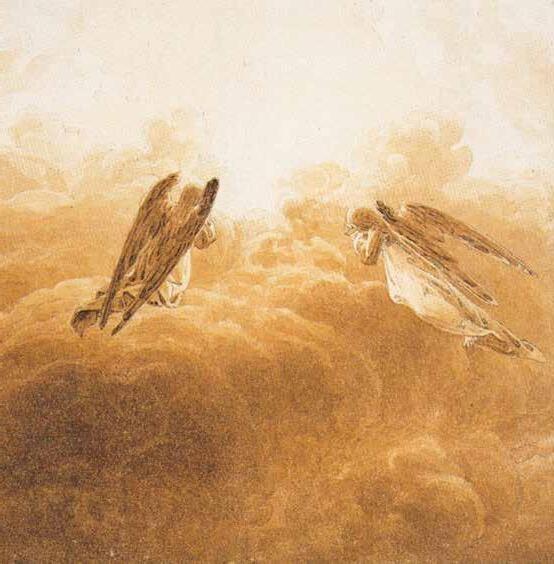






 Dina Gilbert
Dina Gilbert



